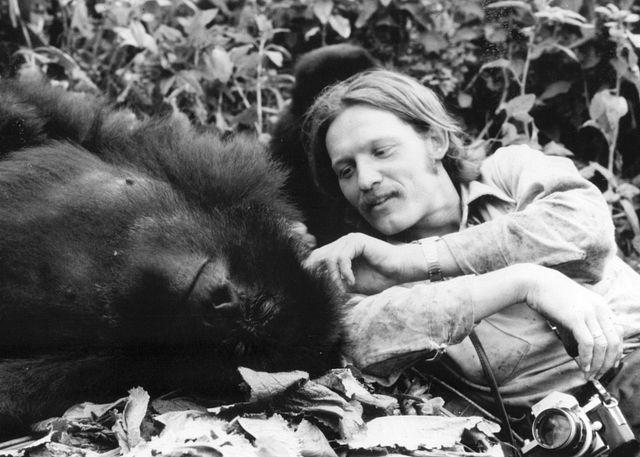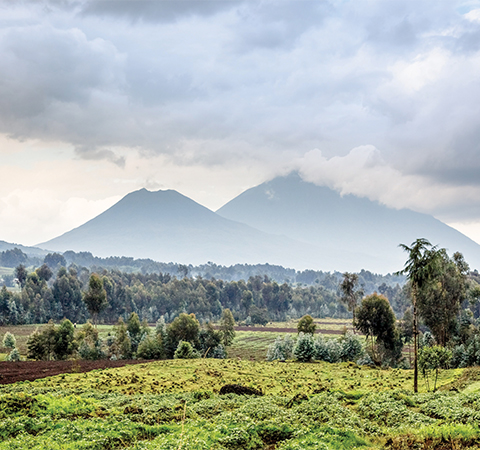Chance encounters turn into a decades-long conservation career

Sundowner Stories are a new blog series of first-hand stories going behind the scenes of AWF’s remarkable history. In the first installment, AWF Senior Vice President Craig Sholley explores how AWF’s innovative mountain gorilla conservation programs over the last 40-plus years have shaped his career and secured a future for the once critically endangered great ape.
In the 1970s, when I was a Peace Corps volunteer teaching science in Zaire, I organized a trip to Tanzania and Kenya over a two-month break. We passed through Nairobi along the way and coincidentally on the street, I saw an intriguing logo — four elephants walking in a line — on a vehicle and asked around.
The logo belonged to a fledgling organization called the African Wildlife Leadership Foundation (AWLF), based in a little office in an apartment building in downtown Nairobi. It was a relatively small space, but the walls were lined with scientific journals. At the time, AWLF was building conservation strategies on a scientific base. The research supported the understanding of specific wildlife behavior and formed the foundation of conservation plans for the continent’s biodiverse landscapes.
My next encounter with the organization (which became AWF in 1983) was a few years later. I was working with Dian Fossey under a L.S.B. Leakey grant at the Karisoke Research Center in Rwanda — thanks to a serendipitous conversation between her and my Peace Corps buddies. I was in the meeting when AWLF approached Dian about creating an integrated approach to mountain gorilla conservation. It involved 24/7 organized security throughout the Volcanoes National Park to address the terrible poaching and working with the park authority to create a general management plan.
The concept also included a really wild and crazy idea — a tourism plan based on offering treks in the park to see habituated gorilla families. It also involved engaging and educating the local community so they could understand the tourism plan and how they benefited from protecting biodiversity in the Volcanoes National Park.
Dian said, “Get the hell off my mountain” — she wanted nothing to do with this approach. Astutely, AWF got off the mountain and had a conversation with the Rwandan Office for Tourism and National Parks instead. In 1978, AWF and partners launched the Mountain Gorilla Project.
By then, my grant had ended, and I had returned to the United States, training science educators. In the late 1980s, serendipity again played a role in the invitation I received from AWF to direct the Mountain Gorilla Project’s work in Volcanoes National Park. Ultimately the program evolved into the International Gorilla Conservation Programme (IGCP), which now covers all of the mountain gorilla range in the Democratic Republic of Congo and Uganda.

Volcanoes National Park in Rwanda
I am extraordinarily proud to have been part of initiating a sustainable tourism model that still generates revenue for the country and for the community. AWF maintained this support during Rwanda’s genocide in 1994, negotiating for the first time ever on behalf of an endangered species amid a war zone. We conceived the Sabyinyo Silverback Lodge — a community enterprise owned and to a degree operated by a community trust — and launched it in 2007. Since then, the lodge has earned the trust close to US $5 million in revenue. We then applied the same concept across the border in Uganda with the Clouds Mountain Lodge, which opened in 2008.
In 2018, we worked with the Rwanda Development Board (RDB) to explore the possibility of expanding the boundaries of Volcanoes National Park to increase habitat for mountain gorillas — the only great ape in the world whose population is growing. AWF donated 27.8 hectares adjacent to the park, marking the first expansion in about 40 years.
It might not have been a big chunk of land, but it was significant in that it established a precedent that allows us to engage in a bigger conversation with RDB. AWF is the technical lead working with RDB over the course of the next 10 or 12 years to restore the Volcanoes National Park and provide habitat for a 15-20 percent population growth of mountain gorillas. As revenues from tourism rise, so does the quality of life of thousands of Rwandans living close to the protected area.
Having spent a large part of my life playing a role in mountain gorilla conservation, I consider myself a very lucky guy. I was on the frontline when their population teetered at about 220, and to see their numbers grow in excess of 1,000 makes me extraordinarily proud.
When you have been a part of creating a model that is successful from a conservation standpoint and a development standpoint, linking people and biodiversity, you understand the potential for these models to be replicated elsewhere in Africa and the world. If humankind cannot protect mountain gorillas, then the likelihood that we are going to protect the broader scope of global biodiversity is exceedingly slim.
In the next Sundowner Stories, we will explore AWF’s pivotal role in setting up community-owned conservancies in Kenya and Tanzania as sustainable conservation enterprises based on large landscape conservation.